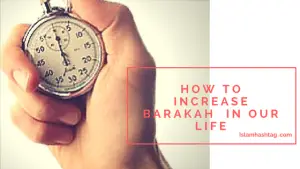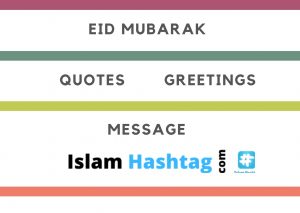What is a Prayer Matt/ Prayer Rug?
Contents
hide
Different types of Prayer Matt/ prayer Rug:
Prayer Rug are Available in different forms. Some Prayer Rugs come with Compass,Some are designed for travel and some have a different gift packaging. Before telling you the story of the designs and figures you see inside your Prayer Rug,let me just Outline You the different types of Prayer Rug available in the Market.They are:-- Persian Prayer Rug
- Turkish Prayer Rug
- Prayer rug in gift pack
- Prayer rug in leather case
- Prayer Rug with compass
- Travel prayer mat
- Pocket prayer mat
- Prayer mats
- Printed or Plain
- Luxary padded -for people with soft knees
- Innovative Prayer mat
Have You Ever Wondered What the Geometry and Patterns in the Prayer Matt Mean?
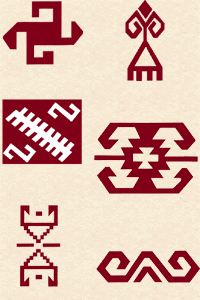 The Geometry and Patterns in the Turkish Rugs are called Motifs.Motifs in Turkish rugs are a complete language. They are very interesting fact about Turkish Rugs. They are the expressions of the weaver who are generally women.Since a carpet is more of a work of art, each design has a deeper meaning. A carpet is more likely to a poem; neither can tolerate any extra element which does not contribute to its wholeness and value.Therefore, just like in a poem, each pattern of a carpet is like each verse of a poem.It is chosen for its beauty and motifs are carefully arranged to form rhymes of fascinating Turkish Carpets.In general same regions have same motifs. It is like people talking same language. Motifs depend on the period which they belong in history and the place where they live. They are live words.So Personally,I Would Prefer my Prayer Rug to be Plain without these Motifs who Knows what these Motifs Mean.
The Geometry and Patterns in the Turkish Rugs are called Motifs.Motifs in Turkish rugs are a complete language. They are very interesting fact about Turkish Rugs. They are the expressions of the weaver who are generally women.Since a carpet is more of a work of art, each design has a deeper meaning. A carpet is more likely to a poem; neither can tolerate any extra element which does not contribute to its wholeness and value.Therefore, just like in a poem, each pattern of a carpet is like each verse of a poem.It is chosen for its beauty and motifs are carefully arranged to form rhymes of fascinating Turkish Carpets.In general same regions have same motifs. It is like people talking same language. Motifs depend on the period which they belong in history and the place where they live. They are live words.So Personally,I Would Prefer my Prayer Rug to be Plain without these Motifs who Knows what these Motifs Mean.The Turkish Prayer rug and the Persian Prayer Rug:
Prayer rugs are Most Commonly Sold as the Turkish prayer rug and the Persian prayer rug.The difference between them is the knot type used to weave and motifs.The Persian Prayer Rug
Design, materials, dyeing, and weaving are all major factors in the Persian prayer rug and are what make each rug a part of history and the Islamic religion. These rugs are decorated with geometric and floral designs because idolization is not permitted in the Islamic religion.In the center or the field of each rug there is a prayer niche derived from mosque architecture and is supported by two columns. The materials used to make the ornate carpets are wool, camel fur, goat’s hair, silk,and cotton.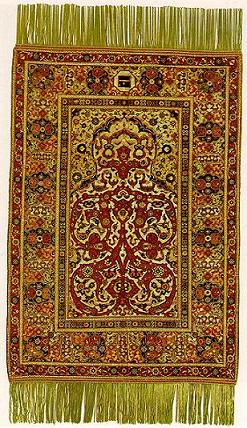 Each fiber used in this craft is used for different reasons, for example,silk is fine and strong so it is likely to have a clear structural pattern. Before the material is used it must go through a washing stage and then it is hung to dry for six weeks.The dyes used in the decoration process are extracted from plants such as the vibrant blue color extracted from indigo.Traditional dyes such as this were passed down from generation to generation. Once the materials were gathered and the dyes were made the weaving process began. Skilled craftsmen produced these carpets on a structure called a loom. There are two major types of weaving, the weft weave and the weft- wrapped weave each having a different complex knot construction.Each of these elements pieced together makes the Islamic prayer rug an intricacy part of the Islamic Religionperhaps the best known Persian rug design is that of the prayer arch, which is used in all Persian prayer rugs.In its simplest form this is a rectangular design woven parallel to the edges.The most common version is where one end of the rectangle has its corners angled off to form a pointed arch, a mihrab.
Each fiber used in this craft is used for different reasons, for example,silk is fine and strong so it is likely to have a clear structural pattern. Before the material is used it must go through a washing stage and then it is hung to dry for six weeks.The dyes used in the decoration process are extracted from plants such as the vibrant blue color extracted from indigo.Traditional dyes such as this were passed down from generation to generation. Once the materials were gathered and the dyes were made the weaving process began. Skilled craftsmen produced these carpets on a structure called a loom. There are two major types of weaving, the weft weave and the weft- wrapped weave each having a different complex knot construction.Each of these elements pieced together makes the Islamic prayer rug an intricacy part of the Islamic Religionperhaps the best known Persian rug design is that of the prayer arch, which is used in all Persian prayer rugs.In its simplest form this is a rectangular design woven parallel to the edges.The most common version is where one end of the rectangle has its corners angled off to form a pointed arch, a mihrab.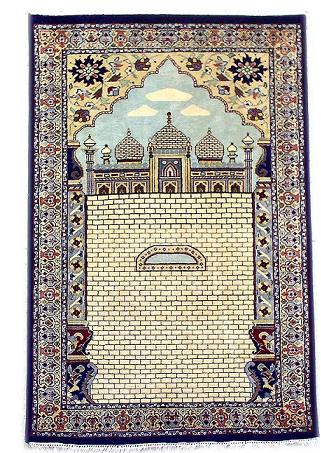 When a Muslim kneels to pray, he rests his forehand within the mihrab, which represents the doorway of the revered Sacred Mosque in Mecca.If the rug is made by nomads, the mihrab is sometimes further simplified so that two-thirds of the way up, the rectangle is narrowed abruptly to form a small square at one end of the carpet. Usually Persian prayer rugs will have only a single mihrab expect when the rug is intended to be used by the family simultaneously or is intended for the mosque.Prayer Rugs with multiple mihrabs are produced occasionally in Persia(and in the Caucasus region of Russia), but they are more typical of Turkish rugs.
When a Muslim kneels to pray, he rests his forehand within the mihrab, which represents the doorway of the revered Sacred Mosque in Mecca.If the rug is made by nomads, the mihrab is sometimes further simplified so that two-thirds of the way up, the rectangle is narrowed abruptly to form a small square at one end of the carpet. Usually Persian prayer rugs will have only a single mihrab expect when the rug is intended to be used by the family simultaneously or is intended for the mosque.Prayer Rugs with multiple mihrabs are produced occasionally in Persia(and in the Caucasus region of Russia), but they are more typical of Turkish rugs. 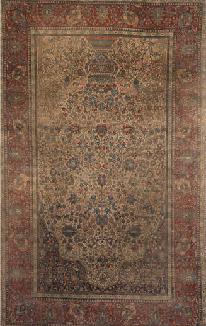 Persian prayer rugs made by nomadic tribes or in small Persian villages often have centers which are either plain and undecorated or are filled with small stylized flowers, stars or a stylized tree of life, symbolic of the garden of paradiseTree of life represents eternal life. This design occurs mainly in Persian, especially in the towns of Isfahan, Qum and Tabrizwhere they produce remarkably lifelike trees.Occasionally you may find a Persian prayer rug where two trees of life, their branches entwined, are growing within the same rug. These are called marriage-tree, most often found among the work of the weavers of Tabriz and Qum.
Persian prayer rugs made by nomadic tribes or in small Persian villages often have centers which are either plain and undecorated or are filled with small stylized flowers, stars or a stylized tree of life, symbolic of the garden of paradiseTree of life represents eternal life. This design occurs mainly in Persian, especially in the towns of Isfahan, Qum and Tabrizwhere they produce remarkably lifelike trees.Occasionally you may find a Persian prayer rug where two trees of life, their branches entwined, are growing within the same rug. These are called marriage-tree, most often found among the work of the weavers of Tabriz and Qum.The Turkish Prayer Rug
Turkish prayer rugs are mainly known after the names of the regions of Turkey. These rugs are therefore named as Bursa prayer rugs, Ladik prayer rugs, Ghiordes prayer rugs, Kirsehir and Mucur prayer rugs, Konya prayer rugs, Megri prayer rugs, Oushak prayer rugs, Panderma prayer rugs, Transylvanian prayer rugs, Melas prayer rugs, Kula prayer rugs, Bergama prayer rugs, etc.- Kirsehir and Mucur Prayer Rugs are also one of the famous Turkish prayer rugs. The Kirsehir and Mucur Prayer Rugs feature niches with double or triple outlines and their color schemes include two or three tones of red.
- Konya Prayer Rugs are the Turkish prayer rugs from the modern Konya, Turkey. Konya was a weaving center since at least the Seljuk invasion in the eleventh century. It was the capital of the Seljuk Turks from 1063 to 1309. Dominated by radish orange and yellow colors, the Konya Prayer Rugs feature symmetrical floral designs.
- Megri Prayer Rugs are the Turkish prayer rugs that feature the symmetrical floral design square borders. The rugs have complex designs at center.
- Oushak Prayer Rugs are the Turkish prayer rugs from Oushak in western Turkey. Oushak has been a center of weaving since at least the 15th century. Dominated by the radish brown colors, the Oushak Prayer Rugs feature symmetrical rectangular designs.
- Panderma Prayer Rugs are the Turkish prayer rugs featuring threshold and chandelier designs. Dominated by the natural yellow, the Transylvanian prayer rugs symmetrical hooked designed borders.
- Melas prayer rugs are the Turkish prayer rugs from Melas, a town in the Bergamo area. Melas prayer rugs are woven using a number of natural dyes. Kula Prayer Rugs are the Turkish prayer rugs from Kula, a District in the Province of Manisa, and Bergama Prayer Rugs are the Turkish prayer rugs from Bergama, Turkey.
What does the Decoration and Design of Prayer Prayer matt / Praye Rug Represent?
An important factor in the Turkish Prayer rug is how it is decorated and designed. Most of the designs that you see on the Prayer Rugs have been influenced by the original Turkish prayer rugs, which are said to have come around in the 9th century.The depiction of animals and humans are not permitted in the designs of these carpets because there is no idolization in the Islamic religion. These rugs are usually decorated in floral and geometric patterns called “Arabesque”.Prophet Muhammad spoke against the artistic representation of human and animal.Muhammad also stated that the rugs should not be elaborately decorated because it might devoid your attention from prayer, but they do not adhere to this.The floral designs are more stylized and rectilinear than the geometric design. Most flowers and plants depicted in the rugs have a special meaning. For example the cypress tree represents mourning as well asimmortality through death. The palm tree and the coconut representblessing and fulfillment and the peony is a metaphor for wealth. The geometric symbols used to decorate prayer rugs are also significant, such as the crescent moon that signifies faith and the endless knot that representswisdom and immortality.Some include a lamp hanging from the arch of whose light symbolized the presence of Allah. It may include handprints or a pair of feet shown on the rug to mark the place of the worshipper as a sort of guide in prayer. As well as, water jugs and combs.Some rugs contain a mini-bar, from which the Koran is read.Calligraphy was used in decoration to state religious motifs and prayers from the Koran as well.
The decoration of the Turkish prayer rug also has its ties to the Islamic religion as each rug is decorated with a prayer niche, a concept adopted from mosque architecture.Inside the niche there is usually a hanging lamp or flowers and two columns that support it.The whole layout of the rug is centered around the niche.The niche lies in the field or ground, and is the surrounded by four spandrels in each of the four corners.Outside the spandrel is the elaborately decorated inner guard strip, then comes the main border, and then the outer guard strip. If there is more than one niche then more than one person was meant to sit on it.Turkish Prayer Rug have always been an important factor in the decoration of these Islamic religious symbols.
The geometric symbols used to decorate prayer rugs are also significant, such as the crescent moon that signifies faith and the endless knot that representswisdom and immortality.Some include a lamp hanging from the arch of whose light symbolized the presence of Allah. It may include handprints or a pair of feet shown on the rug to mark the place of the worshipper as a sort of guide in prayer. As well as, water jugs and combs.Some rugs contain a mini-bar, from which the Koran is read.Calligraphy was used in decoration to state religious motifs and prayers from the Koran as well.
The decoration of the Turkish prayer rug also has its ties to the Islamic religion as each rug is decorated with a prayer niche, a concept adopted from mosque architecture.Inside the niche there is usually a hanging lamp or flowers and two columns that support it.The whole layout of the rug is centered around the niche.The niche lies in the field or ground, and is the surrounded by four spandrels in each of the four corners.Outside the spandrel is the elaborately decorated inner guard strip, then comes the main border, and then the outer guard strip. If there is more than one niche then more than one person was meant to sit on it.Turkish Prayer Rug have always been an important factor in the decoration of these Islamic religious symbols.How to Check the Quality of Turkish Prayer Rug
Turn the Turkish Prayer rug upside down and look at the back.The more distinctly the design shows on the back, greater the number of knots, the better the quality of the rug.In other words, the greater the number of hand-tied knots per square inch (KPSI) the finer the piece: 150 knots per square inch is average;”fine” rugs may have a knot count of 500 or more.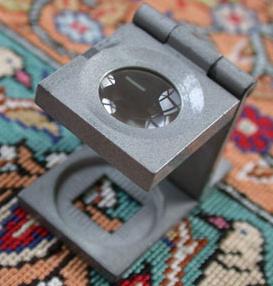 Typically, higher knot counts are found in rugs with which have floral or curvilinear patterns.The higher knot count allows leaves, flowers and curvilinear patterns to be woven in a complex manner and the curves to be formed more elagance and beauty.As the geometric shapes tend to have straight lines and angles, rugs with geometric patterns do not require many knots per square inch. Pattern type and desired design assigns the knot size. The knots size do not determine the quality of the oriental rug by itself!A higher knot count rug is often more expensive than a lower knot count rug because weave is finer and more time has been spent on the rug.On the other hand, a rug of different origin and different design may be more expensive, even though it has a lower knot count.Keep in mind that knot count is only one measure of a rug’s quality!Also beware on judging rugs on knots per square inch, because some dealers may inflate the knot size. Don’t get trapped. You can easily measure it. Ask them to do it!
Typically, higher knot counts are found in rugs with which have floral or curvilinear patterns.The higher knot count allows leaves, flowers and curvilinear patterns to be woven in a complex manner and the curves to be formed more elagance and beauty.As the geometric shapes tend to have straight lines and angles, rugs with geometric patterns do not require many knots per square inch. Pattern type and desired design assigns the knot size. The knots size do not determine the quality of the oriental rug by itself!A higher knot count rug is often more expensive than a lower knot count rug because weave is finer and more time has been spent on the rug.On the other hand, a rug of different origin and different design may be more expensive, even though it has a lower knot count.Keep in mind that knot count is only one measure of a rug’s quality!Also beware on judging rugs on knots per square inch, because some dealers may inflate the knot size. Don’t get trapped. You can easily measure it. Ask them to do it!How to check the Quality of prayer matt if they Would leave off Colour or not?
If You want your prayer Rug to be durable for years,Try the prayer Rugs with Natural Dyes and not the Synthetic Ones.Natural Dyes are so much better than synthetics. They will not change for years.In direct sunlight synthetic dyes will change their color while natural dyes get brighter and more beautiful.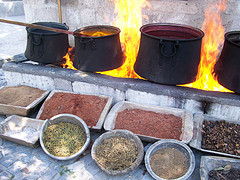 When you drag a coin to a rug synthetic dyes will come off from carpet.Natural dyes don’t come off from carpet.If you look closer to the rug, deeper parts have the same color if it is natural.And If You check your synthetic dyed rug and look at the inner sides.You will see that the colors are different from the surface.Natural dyes are durable and don’t change for hundreds of years.
When you drag a coin to a rug synthetic dyes will come off from carpet.Natural dyes don’t come off from carpet.If you look closer to the rug, deeper parts have the same color if it is natural.And If You check your synthetic dyed rug and look at the inner sides.You will see that the colors are different from the surface.Natural dyes are durable and don’t change for hundreds of years.About the Electronic Prayer rug
Good News! The latest Rug Coming up in few days are the Electronic Prayer Rug which will help you keep count of the Rakats:Om Makhachkala in Dagestan, southern Russia, has come up with an out of the ordinary new product. Developer Eldar Klyichev has designed an electronic prayer mat, which helps Muslims to keep track of rakats, the ritual movements and words used during Islamic prayer.The electronic prayer mat is equipped with touch sensors which help users not to lose count during prayers. If a worshipper makes a mistake, forgetting the order or changing position at the wrong time, the sensors begin to vibrate, helping them to realise their mistake without disturbing the ritual.Prayer rugs can be purchased via Amazon:some links for your ease:Modefa Turkish prayer rug (Amazon)Modefa Velvet Turkish prayer rug(amazon_Mihrab Style Velvet Prayer Rug
Nasreen started with 100 Darood Sharif and now reads abundant azkar daily. Alhumdulillah, Now she spends close to three hours in dhikr. Would you like to build your dhikr habit too?
It’s completely free — try the digital tasbih counter here:
We recommend using simple prayer rug which does not has lots of designs because Prayer is a means of connection to Allah and there should be no distraction. Any clean piece of fabric can be used as a prayer rug. If you are someone who easily get distracted by pattern and design, you can choose a plain prayer rug. People who have knee problem can choose velvet prayer rug which has a bit of cushion. Ref :- http://www.ewdn.com/2014/08/27/electronic-prayer-mat-invented-in-dagestan/
- https://en.wikipedia.org/wiki/Prayer_rug
- http://www.rugs-oriental.net/
Discover more from Islam Hashtag
Subscribe to get the latest posts sent to your email.


